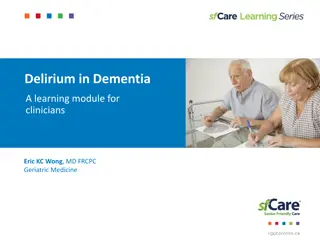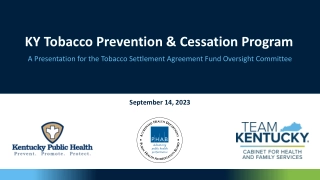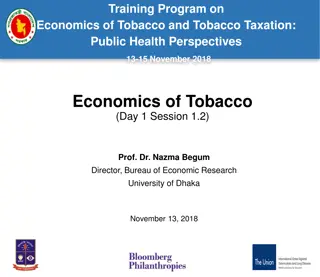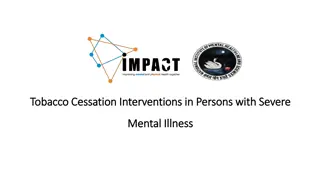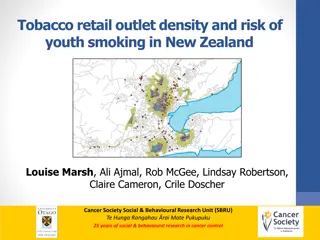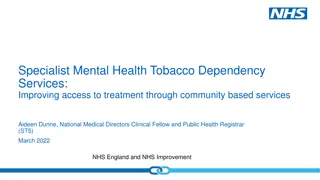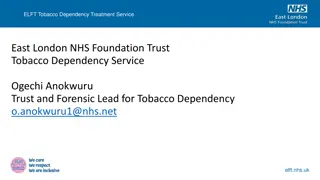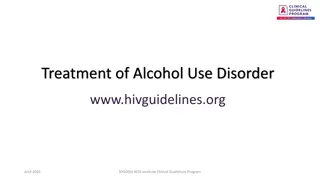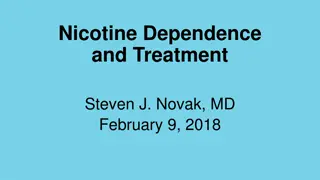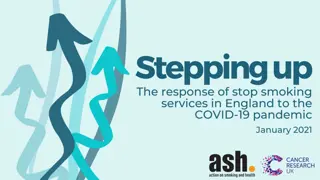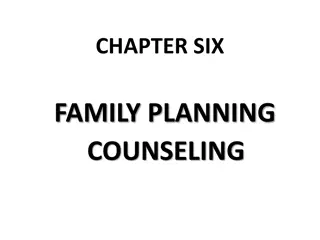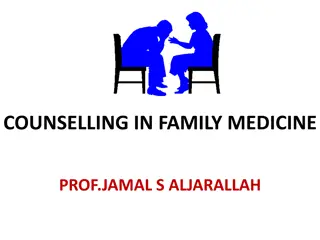Tobacco Treatment Counseling: Strategies and Guidelines for Clinicians
Effective tobacco treatment counseling strategies, including addressing physiological and behavioral aspects of dependence, offering pharmacological treatments, and utilizing various clinician types, can significantly increase the likelihood of successful smoking cessation. Clinician interventions play a crucial role in helping individuals quit smoking, with a dose-response relationship observed in follow-up care sessions. Recommendations emphasize the importance of screening all patients for tobacco use, advising them to quit, and providing appropriate interventions. By leveraging clinician assistance, patients have higher odds of successfully quitting smoking for an extended period.
- Tobacco Treatment
- Counseling Strategies
- Smoking Cessation
- Clinician Interventions
- Tobacco Dependence
Download Presentation

Please find below an Image/Link to download the presentation.
The content on the website is provided AS IS for your information and personal use only. It may not be sold, licensed, or shared on other websites without obtaining consent from the author. Download presentation by click this link. If you encounter any issues during the download, it is possible that the publisher has removed the file from their server.
E N D
Presentation Transcript
TOBACCO TREATMENT COUNSELING STRATEGIES
TOBACCO DEPENDENCE: A 2-PART PROBLEM Tobacco Dependence Physiological Behavioral The addiction to nicotine The habit of using tobacco Treatment Treatment Medications for cessation Behavior change program Treatment should address the physiological and the behavioral aspects of dependence.
RECOMMENDATIONS to TREAT TOBACCO USE in PSYCHIATRY In terms of lives saved, quality of life, and cost-efficacy, treating smoking is considered the most important activity a clinician can do. -- John Hughes, MD Professor of Psychiatry University of Vermont
TOBACCO TREATMENT GUIDELINES All patients ought to be screened for tobacco use, advised to quit, and offered intervention All patients should be offered pharmacological treatment for quitting smoking, unless contraindicated There is a dose response relationship with the amount of contact provided American Psychiatric Association, 2006; U.S. Public Health Service, 2008
EFFECTS of CLINICIAN INTERVENTIONS With help from a clinician, the odds of quitting approximately doubles. Estimated abstinence at 30 n = 29 studies Compared to patients who receive no assistance from a clinician, patients who receive assistance are 1.7 2.2 times as likely to quit successfully for 5 or more months. 5+ months 20 2.2 1.7 10 1.1 1.0 0 No clinician Self-help material Nonphysician clinician Physician clinician Type of Clinician Fiore et al. (2008). Treating Tobacco Use and Dependence: 2008 Update. Clinical Practice Guideline. Rockville, MD: USDHHS, PHS, May 2008.
The NUMBER of CLINICIAN TYPES CAN MAKE a DIFFERENCE, too 30 n = 37 studies Estimated abstinence Compared to smokers who receive assistance from no clinicians, smokers who receive assistance from two or more clinician types are 2.4 2.5 times as likely to quit successfully for 5 or more months. rate at 5+ months 2.5 2.4 20 1.8 10 1.0 0 None One Two Three or more Number of Clinician Types Fiore et al. (2008). Treating Tobacco Use and Dependence: 2008 Update. Clinical Practice Guideline. Rockville, MD: USDHHS, PHS, May 2008.
DOSE RESPONSE RELATIONSHIP of FOLLOW UP CARE Number of sessions Estimated quit rate* 0 to 1 12.4% 2 to 3 16.3% 4 to 8 20.9% More than 8 24.7% * 5 months (or more) post-cessation Fiore et al. (2008). Treating Tobacco Use and Dependence: 2008 Update. Clinical Practice Guideline. Rockville, MD: USDHHS, PHS, May 2008.
WHY MENTAL HEALTH PROVIDERS? Often the clinician for whom contact is the most frequent and who knows the patient best Able to combine psychopharmacological and behavioral/counseling treatment Trained in substance abuse treatment Able to identify and address any changes in psychiatric symptoms during the quit attempt Failure to address tobacco use tacitly implies that quitting is not important or that the patient is not worth helping.
The 5 As for TREATING TOBACCO ASK about tobacco USE ADVISE tobacco users to QUIT ASSESS READINESS to make a quit attempt ASSIST with the QUIT ATTEMPT ARRANGE FOLLOW-UP care
The 5 As: ASK about tobacco use; with a tone that conveys sensitivity, concern and is non-judgmental: ASK Do you smoke or use other types of tobacco or nicotine, such as e-cigarettes? It s important for us to have this information so we can check for potential interactions between tobacco smoke and your other medicines. We ask all of our patients, because tobacco smoke can affect how some medicines work. We care about your health, and we have resources to help our patients quit smoking. Has there been any change in your smoking status?
The 5 As: ADVISE tobacco users to quit (clear, strong, personalized) ADVISE Quitting smoking is the most important thing you can do to protect your health now and in the future. I have training to help my patients quit, and when you are ready, I can work with you to design a specialized treatment plan. 52% of psychiatric patients who smoke report never having been advised to quit by a mental healthcare provider (Prochaska et al., 2005)
The 5 As: ASSESS and ASSIST ASSESS readiness to make a quit attempt ASSIST with the quit attempt Not ready to quit: enhance motivation (the 5 R s) Ready to quit: design a treatment plan Recently quit: relapse prevention
READINESS to QUIT Quit date + 6 months - 30 days Not ready to quit Recent quitter Former tobacco user Enhance motivation Behavioral counseling Behavioral counseling The 5 R s Pharmacotherapy Relapse prevention Relapse prevention Ready to quit Behavioral counseling Pharmacotherapy The 5 A s
READINESS to QUIT SMOKING* Intend to quit in next 6 mo Intend to quit in next 30 days Smokers with mental illness or addictive disorders are just as ready to quit smoking as the general population of smokers. General Population 40% 20% General Psych Outpts 43% 28% Depressed Outpatients 55% 24% Psych. Inpatients 41% 24% Methadone Clients 48% 22% 0% 20% 40% 60% 80% 100% * No relationship between psychiatric symptom severity and readiness to quit
ASSIST: TAILOR TREATMENT to PATIENTS READINESS to QUIT Does the patient now use tobacco? Yes No Is the patient now ready to quit? Did the patient once use tobacco? Yes No Yes No Encourage continued abstinence Provide treatment Prevent relapse* Promote motivation *Relapse prevention interventions not necessary if patient has not used tobacco for many years and is not at risk for re-initiation. Fiore et al. (2008). Treating Tobacco Use and Dependence: 2008 Update. Clinical Practice Guideline. Rockville, MD: USDHHS, PHS, May 2008.
ASSIST: NOT READY to QUIT STAGE 1: Not ready to quit Not thinking about quitting in the next month Some patients are aware of the need to quit. Patients struggle with ambivalence about change. Patients are not ready to change, yet. Pros of continued tobacco use outweigh the cons. GOAL: Start thinking about quitting.
STAGE 1: NOT READY to QUIT Counseling Strategies DO DON T Strongly advise to quit Persuade Provide information Cheerlead Ask noninvasive questions; identify reasons for tobacco use Tell patient how bad tobacco is, in a judgmental manner Raise awareness of health consequences/concerns Provide a treatment plan Demonstrate empathy, foster communication Leave decision up to patient
RAISING AWARENESS: TOBACCO USE MOOD LOG Use the Mood Log to raise patients awareness of their tobacco use For each day, patient should record # of cigarettes smoked, # of pleasant activities, and provide a mood rating. Review log sheets with patient to identify relationship between smoking, activities / isolation, and mood Is patient s tobacco use associated with isolation and poorer mood?
SUMMARY: PATIENTS NOT yet READY to QUIT Clinician goals include Building rapport Planting a seed to move patient forward Opening a door to facilitate further counseling Helping patients become more aware of their smoking behavior Providing education and establishing yourself as a resource
CASE 1: Vera 48 year old divorced woman Dual diagnosis treatment facility Bipolar disorder, alcohol dependence, h/c crack cocaine dependence Smokes 1.5 packs/day I ll likely die with a cigarette in my mouth
ASSIST: TAILOR TREATMENT to PATIENTS READINESS to QUIT Does the patient now use tobacco? Yes No Is the patient now ready to quit? Did the patient once use tobacco? Yes No Yes No Encourage continued abstinence Promote motivation Provide treatment Prevent relapse* *Relapse prevention interventions not necessary if patient has not used tobacco for many years and is not at risk for re-initiation. Fiore et al. (2008). Treating Tobacco Use and Dependence: 2008 Update. Clinical Practice Guideline. Rockville, MD: USDHHS, PHS, May 2008.
ASSIST: READY to QUIT STAGE 2: Ready to quit Ready to quit in the next month Patients are aware of the need to, and the benefits of, making the behavioral change. Patients are getting ready to take action. GOAL: Achieve cessation.
STRATEGIES for PATIENTS READY to QUIT Key Questions to Ask: Why do you want to quit now? How confident are you that you ll be able to quit? Have you quit in the past? What worked for you then? What are key triggers for you with smoking? How do stress and your mood play into your smoking? Who can support you with quitting? What concerns do you have about quitting? (withdrawal symptoms, weight gain, coping with stress) How can we work together to manage your anxiety (or other psychiatric symptoms) during the quitting process?
STRATEGIES for PATIENTS READY to QUIT DOs Discuss and develop coping strategies Offer pharmacological treatment, unless contraindicated Set a quit date! Schedule follow up visit
COPING with QUITTING Cognitive Coping Strategies Review commitment to quit Distractive thinking Positive self-talk Relaxation through imagery Mental rehearsal and visualization Remind yourself that urges are brief.
COPING with QUITTING (contd) Cognitive Coping Strategies: Examples Thinking about cigarettes doesn t mean you have to smoke one: Just because you think about something doesn t mean you have to do it! Tell yourself, It s just a thought, or I am in control. As soon as you get up in the morning, look in the mirror and say to yourself: I am proud that I made it through another day without tobacco. Reframe how you think about yourself: Begin thinking of yourself as a non-smoker, instead of as a struggling quitter
COPING with QUITTING (contd) Behavioral Coping Strategies Control your environment Tobacco-free home and workplace Remove cues to tobacco use; actively avoid trigger situations Modify behaviors that you associate with tobacco: when, what, where, how, with whom Substitutes for smoking Water, sugar-free chewing gum or hard candies (oral substitutes) Minimize stress where possible, obtain social support, take a break, and alleviate withdrawal symptoms
STRESS MANAGEMENT The Facts The Myths There will always be stress in one s life Smoking gets rid of all my stress There are many ways to relax without a cigarette I can t relax without a cigarette Smokers confuse the relief of withdrawal with the feeling of relaxation STRESS MANAGEMENT SUGGESTIONS: Deep breathing, shifting focus, taking a break
SOCIAL SUPPORT for QUITTING Key ingredients for successful quitting: Social support as part of treatment (intra-treatment) Social support outside of treatment (extra-treatment) PATIENTS SHOULD BE ADVISED TO: Ask family, friends, and coworkers for support ask them not to smoke around you and not to leave cigarettes out Get individual, group, or telephone counseling Patients who receive social support and encouragement are more successful in quitting
The FIVE As: ARRANGE Arrange follow-up care ARRANGE Follow-up in person or via phone within 1 to 3 days after quit attempt Congratulate success Address lapses let a slip slide Assess pharmacotherapy use and problems
CASE 6: Mr. Brooks 58 year old divorced male, unemployed PTSD clinic at Veteran s Hospital PTSD, h/o polysubstance abuse, chronic pain Smokes 1.5 packs per day Interested in quitting
ASSIST: TAILOR TREATMENT to PATIENTS READINESS to QUIT Does the patient now use tobacco? Yes No Is the patient now ready to quit? Did the patient once use tobacco? Yes No Yes No Promote motivation Encourage continued abstinence Provide treatment Prevent relapse* *Relapse prevention interventions not necessary if patient has not used tobacco for many years and is not at risk for re-initiation. Fiore et al. (2008). Treating Tobacco Use and Dependence: 2008 Update. Clinical Practice Guideline. Rockville, MD: USDHHS, PHS, May 2008.
ASSESSING READINESS to QUIT (cont d) STAGE 3: Recent quitter Actively trying to quit for good Patients have quit using tobacco sometime in the past 6 months and are taking steps to increase their success. Withdrawal symptoms occur. Patients are at risk for relapse. GOAL: Remain tobacco-free for at least 6 months.
STRATEGIES for RECENT QUITTERS DOs Praise progress - solicit commitment to quit for good Evaluate current quit attempt: Status of attempt Slips or relapse Medication use, plans for discontinuation Ask about social support Identify temptations and triggers for relapse Negative affect, smokers, eating, alcohol, cravings, stress Encourage healthful alternative behaviors to replace tobacco use Offer tips for relapse prevention
RELAPSE PREVENTION for LONG-TERM QUITTERS Relapse Prevention Congratulate success! Encourage continued abstinence Discuss benefits of quitting, problems encountered, successes achieved, and potential barriers to continued abstinence Ask about strong or prolonged withdrawal symptoms (change dose, combine or extend use of medications) Promote smoke-free environments Schedule additional follow-up as needed
SMOKING CESSATION and WEIGHT GAIN CONCERNS
SMOKING CESSATION & WEIGHT GAIN Weight gain a major impediment to quitting smoking, particularly among women Average weight gain: men=6 lbs, women=8 lbs Major weight gain (> 28 lbs) occurred in < 15% Risk factors for post-cessation weight gain African American race, younger age (< 55 yrs), heavier smokers (> 15 cigarettes/day) At baseline smokers weigh less than nonsmokers, they weigh nearly the same after quitting
ADDRESSING CONCERNS about POST CESSATION WEIGHT GAIN Weight Gain Discourage strict dieting while quitting Encourage healthful diet and meal planning Suggest increasing water intake or chewing sugarless gum Recommend selection of nonfood rewards When fear of weight gain is a barrier to quitting Consider pharmacotherapy with evidence of delaying weight gain (bupropion SR or 4-mg nicotine gum or lozenge) Assist patient with weight maintenance or refer patient to specialist or program
ASSIST: TAILOR TREATMENT to PATIENTS READINESS to QUIT Does the patient now use tobacco? Yes No Is the patient now ready to quit? Did the patient once use tobacco? Yes No Yes No Encourage continued abstinence Promote motivation Provide treatment Prevent relapse* *Relapse prevention interventions not necessary if patient has not used tobacco for many years and is not at risk for re-initiation. Fiore et al. (2008). Treating Tobacco Use and Dependence: 2008 Update. Clinical Practice Guideline. Rockville, MD: USDHHS, PHS, May 2008.
READINESS to QUIT: A REVIEW Quit date + 6 months - 30 days Not ready to quit Recent quitter Former tobacco user Enhance motivation Behavioral counseling Behavioral counseling The 5 R s Pharmacotherapy Relapse prevention Relapse prevention Ready to quit Behavioral counseling Pharmacotherapy The 5 A s
INTEGRATING TOBACCO TREATMENT into PSYCHOTHERAPY Quotes from Psychodynamically Trained Faculty Attention to substance abuse is part of psychotherapy and how we address self-defeating, self-destructive behaviors and examine resistance to change and support change. Ideally, link to the central pathology When people are depressed they don t take very good care of themselves. I want to help you take as good care of yourself as possible. If the patient says he needs to smoke to deal with psychiatric symptoms I would respond, Wow, you must have a lot of stress and anxiety if you need to take a cancer-causing agent to deal with it. I think we really need to look at your level of stress. It should be a real priority.
BRIEF COUNSELING: ASK, ADVISE, REFER about tobacco USE ASK ADVISE tobacco users to QUIT REFER to other resources Patient receives assistance from other resources, with follow-up counseling arranged ASSIST ARRANGE
BRIEF COUNSELING: ASK, ADVISE, REFER (cont d) Brief interventions have been shown to be effective In the absence of time or expertise: Ask, advise, and refer to other resources, such as local group programs or the toll-free quitline 1-800-QUIT-NOW This brief intervention can be achieved in less than 1 minute.
CESSATION COUNSELING: SUMMARY Routinely identify tobacco users (ASK) Strongly ADVISE patients to quit ASSESS stage at each contact Tailor intervention messages (ASSIST) Be a good listener Minimal intervention in absence of time for more intensive intervention ARRANGE follow-up Use the referral process, if needed


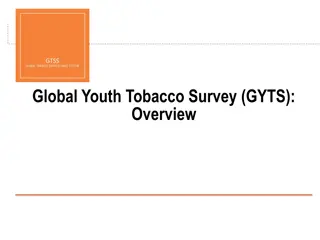
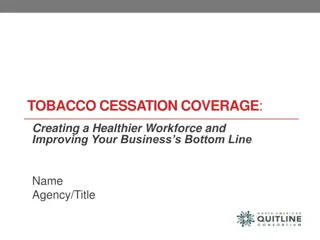
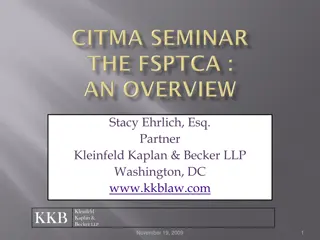


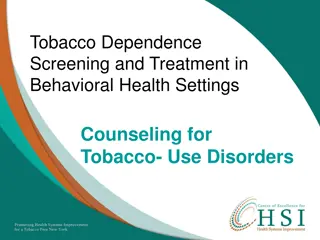
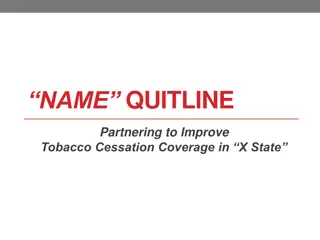

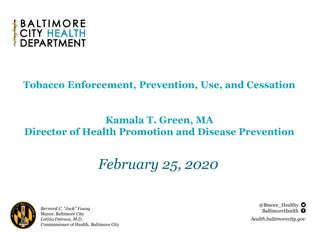
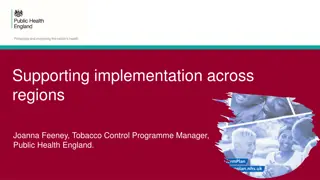
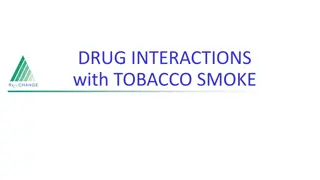

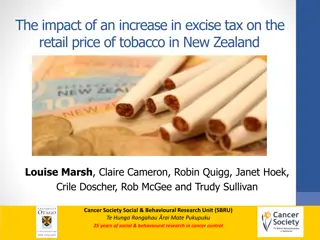
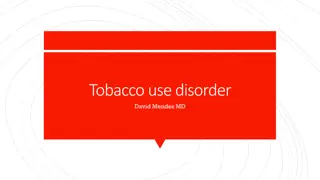
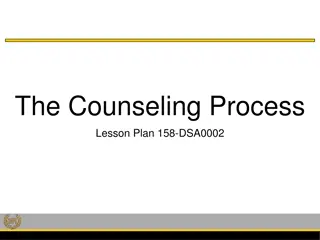
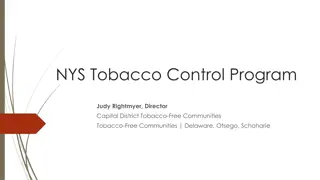

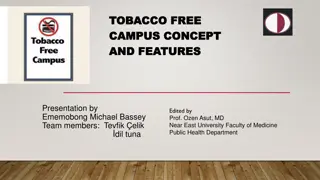
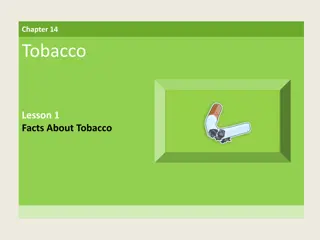
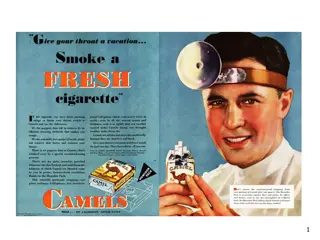



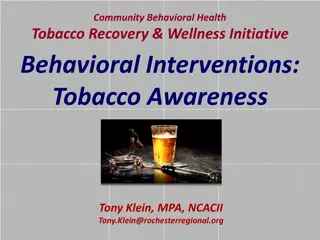
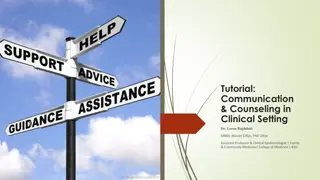
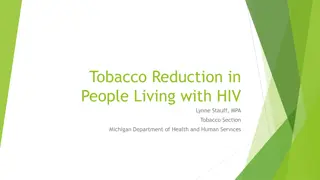

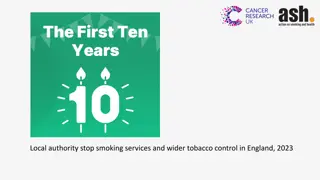
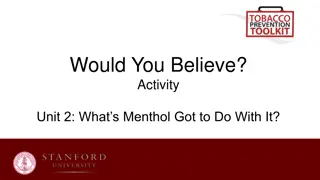
![Protecting Youth Through Tobacco Retail Licensing in [Your County]](/thumb/175307/protecting-youth-through-tobacco-retail-licensing-in-your-county.jpg)
